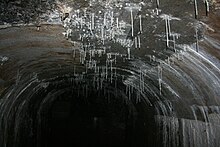Old town air raid shelter
The old town air raid shelter in Iserlohn is a former air raid shelter from the time of National Socialism and the Second World War . The tunnel system is located under the Upper Town Church in the approximately 20 meter high Bilsteinfelsen. It has a total length of about 200 to 250 meters. During the air raids on the city in April 1945, the bunker provided refuge for over 2,000 people seeking protection.
history
Construction of the old town air raid shelter began in the summer of 1943.
In August 1943, a construction program for tunnels, cover ditches, support of cellar ceilings and splinter protection systems, breakthroughs in firewalls, the expansion of an air raid rescue station and an air raid command post was drawn up for the urban area. After inclusion in the air protection guide program expansion, construction work began. In June 1944, the Todt organization approved two other tunnels (Baarstrasse / Stenner and Lünkerhohl / Hardtrücken) in addition to the Inselstrasse / Old Town tunnels as urgent war structures as part of a minimum construction program for Iserlohn. The approval stated, among other things, that the Inselstraße / Altstadt tunnel system could be carried out with four German workers and ten Russian prisoners of war. In July 1944, tunneling in the old town was stopped. One came in loose slate and clay soil, which offered no reliable protection from bomb hits. The stop also took place in favor of the continued construction of the Stenner and Hardtrücken air raid protection systems . Due to the war situation and the associated scarcity of materials, the construction work was reduced to a minimum. There were no irrigation and drainage systems, heating systems, sanitary installations and no concrete floor. Shortly before the city was occupied by American forces on April 16, 1945, the most makeshift measures were almost complete.

According to the original plans, the old town tunnel area should be around 500 to 550 meters in length and was designed for 4,000 to 6,600 people seeking protection. Of the three planned entrances, only two entrances were realized; there were no sanitary rooms. Another narrow shaft rising to the surface was used for ventilation and was intended as an emergency exit.
The Iserlohn City Museum took over the bunker in the summer of 2004 for its educational work. The museum was supported by sponsors from the local economy and a Dortmund company. In 2004, on the occasion of the use of the air raid shelter, an exhibition with the theme “Whoever sows a storm… bombs over Germany - air raid protection in Iserlohn” took place, in which contemporary witnesses report on their experiences in the tunnel, among other places.
A tour of the air raid shelter is possible on a few dates each year. In order not to endanger a possible bat population, the facility should not be used from November to February.
literature
- Documentation: "Whoever sows storms ...", bombs over Germany, air raid in Iserlohn. Gerd Schäfer, Iserlohn 2005.
Web links
Individual evidence
- ↑ a b c City of Iserlohn - old town air raid shelter
- ↑ a b c Documentation: "Wer Sturm sät ...", bombs over Germany, air raid protection in Iserlohn. Gerd Schäfer, Iserlohn 2005.
Coordinates: 51 ° 22 ′ 25.1 ″ N , 7 ° 41 ′ 47 ″ E
